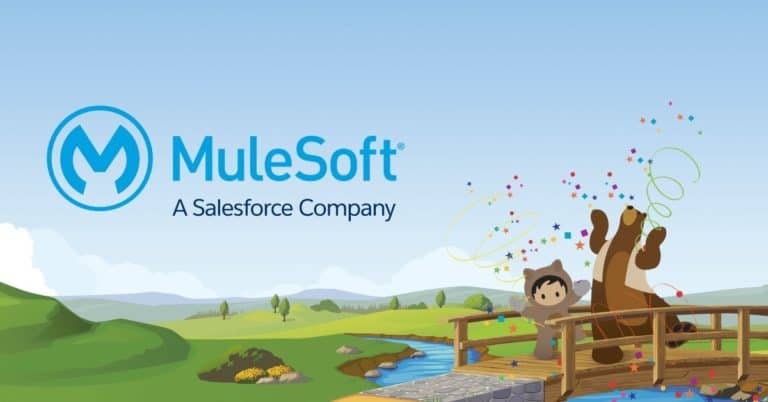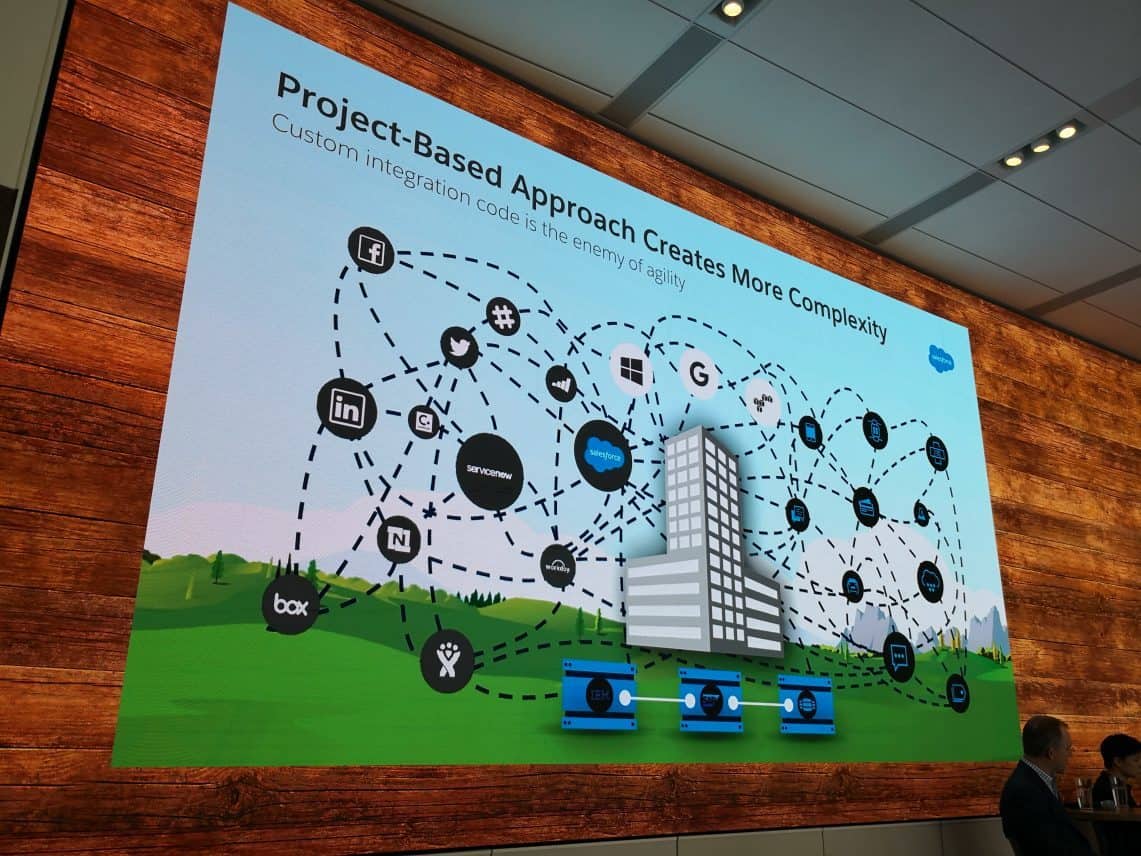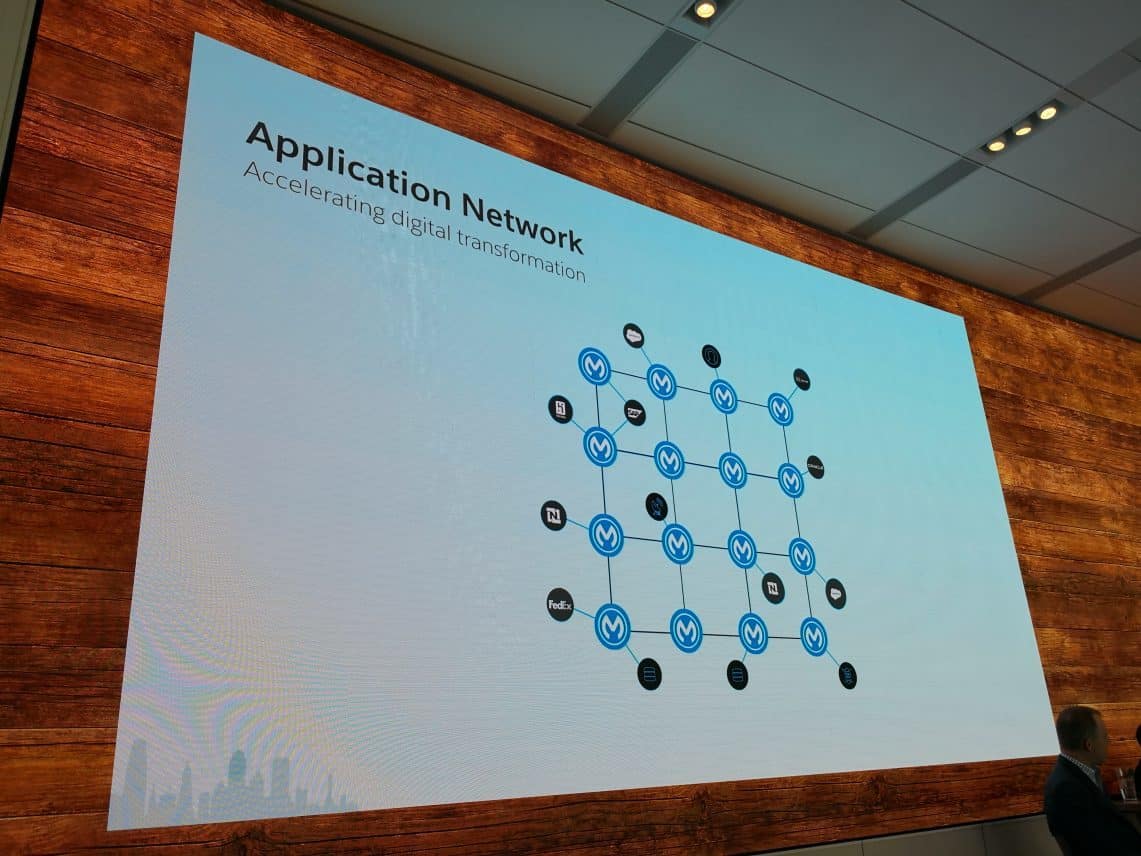Earlier this year, Salesforce acquired Mulesoft for $6.5 billion. This company might be very familiar to some readers and not at all to others. During Dreamforce in San Francisco, we talked to them. What are they doing, why is it so good, and why is it worth so much money?
Mulesoft is a company that offers integrations between different software solutions. It does this by fully supporting the API (Application Programming Interface) of these solutions. Within the Mulesoft platform, it is then possible to use a drag-and-drop editor to build diagrams of what needs to be done in certain scenarios.
For example, if an order is added to the order system, a parcel shipment must be created automatically at a courier company such as PostNL. This could be a very simple integration, but also the duplication of data from a CRM package to a ticket system or customer forum.
Mulesoft is certainly not unique in this respect. During Dreamforce, we spoke to Uri Sarid, CTO of Mulesoft, who acknowledges that the basic product may not be unique. However, the solution does go a few steps further than many competitors. That’s exactly why Salesforce eventually took over the company. In addition, Salesforce has been one of the first investors to do so, which also helps.
Mulesoft goes beyond API integrations
Mulesoft focuses on the complete lifecycle of an application, end-to-end. What is the best way for them to design, develop and ultimately offer their products via APIs so that Mulesoft can offer the right methods and integrations for that? Mulesoft does not pick and choose with an API; it always chooses to support the full API. As a result, enterprise organizations do not encounter the obstacle where integration can only be done for 50 percent.
Of course, it can happen that a company wants to integrate with an API of a lesser-known software solution that is not supported by Mulesoft. There is a fairly simple alternative that every developer can work with. You can import an example of an API call into Mulesoft, which then automatically offers an API method around it. This is very simple, and we have seen it before at other similar companies.
Mulesoft’s platform is also built in such a way that it can work in parallel. So if multiple integrations have to take place at the same time, they can be done in parallel. For example, with Salesforce Customer 360, all integrations can be loaded parallelly, which will save an enormous amount of loading time.
Optimizing, caching and batching
Mulesoft does a lot to keep the loading speed and availability as optimal as possible. For example, it has built a cache engine. As a result, certain data that is often retrieved but little changes can be cached. This allows Mulesoft to deliver the data directly from its own cache without consulting the source (an application). Of course, caching can be arranged per API call, because recent orders are less suitable for caching than, for example, customer data.
Mulesoft also offers the possibility to deliver batches of data to the platform, for example, when large amounts of data need to be moved. This is the case, for example, for machine learning purposes. You need a lot of data that needs to be updated regularly. This does not always work well via an API call, but it can work well and quickly via batches.
With all those years of experience and global availability, Mulesoft can deliver data quickly to any location. It can, therefore, help SaaS applications to integrate their data faster and better, or advise on how to improve the hosting of the API platform. Some startups sometimes encounter the problem that their servers go down when they suddenly become very popular. The API will then be unable to process the number of calls. Mulesoft can often help, by setting a limit and offering certain caching. It can also advise on how to improve availability, how many API calls are currently being missed, and how much capacity is needed.

Mules keep transporting data
One of the other advantages that Mulesoft offers compared to the self-integration of APIs is that the availability is guaranteed. With Mulesoft having a huge number of large enterprise customers, companies with SaaS applications and APIs also tend to involve Mulesoft at an early stage in the development of their product and new APIs or modifications to APIs. As a result, these types of integrations continue to work. Many enterprise organizations have hundreds to thousands of such integrations, if you need to modify them one by one, that’s not a thing to do.
Mulesoft has now also introduced the Mulesoft Graph. This allows you to see how the mules move the data. There are also analytics applied to this data, so you can see exactly how well the integrations work. If a failure occurs because an API is not available, Mulesoft will be able to sound the alarm very quickly. Then it can be solved, or it can be taken into account. Especially the latter can save a lot of money and problems.
Suppose an API is used that checks a credit card number or a postcode/address, but that API doesn’t work. The ordering process then gets stuck, and people can’t complete their order. This can cost a lot of money in a very successful webshop. If you normally receive 10 orders per minute, but due to this malfunction you can’t receive orders for 30 minutes, then 300 orders may have been lost.
Mulesoft applies machine learning to improve integrations
When a Mulesoft customer makes a new connection via Mulesoft between two API’s of applications, there is a learning moment for Mulesoft every time. Each integration offers a possible pattern that can be interesting for multiple customers. In doing so, the company now wants to make a difference by applying machine learning to it. If a hundred customers have made the same connection for you, it can help you to make that connection faster and to match the right data fields. For example, linking an order to a courier company can, if both systems are known, be done with a single click.
The added value of Mulesoft is therefore clear, especially for enterprise companies with hundreds or thousands of integrations. Continuity is guaranteed, if an API changes, Mulesoft will often ensure that everything continues to work as usual. Making integrations is much faster via the drag-and-drop interface and machine learning than programming these kinds of links yourself. Faults are quickly detected, allowing companies to take action on them. This can be done by becoming less dependent on an API, by calling the company to account or simply by choosing a different supplier with a different API.


